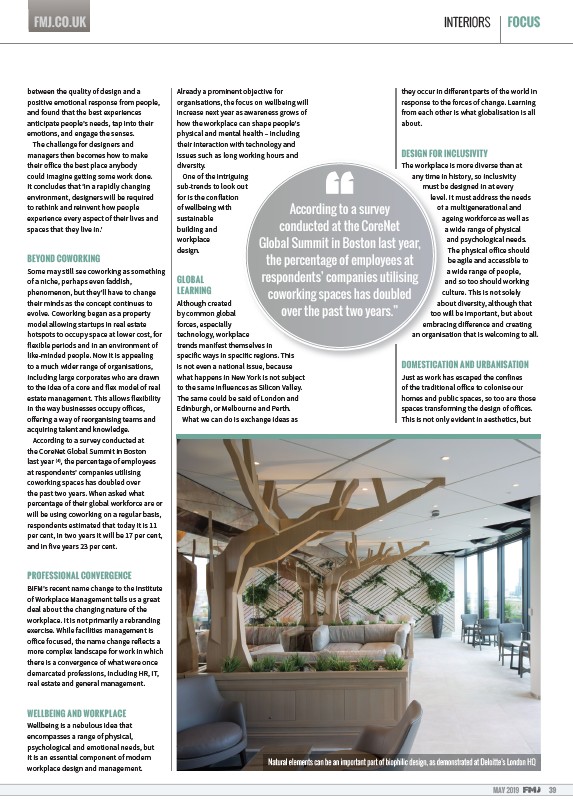
FMJ.CO.UK INTERIORS FOCUS
MAY 2019 39
between the quality of design and a
positive emotional response from people,
and found that the best experiences
anticipate people’s needs, tap into their
emotions, and engage the senses.
The challenge for designers and
managers then becomes how to make
their o ice the best place anybody
could imagine getting some work done.
It concludes that ‘in a rapidly changing
environment, designers will be required
to rethink and reinvent how people
experience every aspect of their lives and
spaces that they live in.’
BEYOND COWORKING
Some may still see coworking as something
of a niche, perhaps even faddish,
phenomenon, but they’ll have to change
their minds as the concept continues to
evolve. Coworking began as a property
model allowing startups in real estate
hotspots to occupy space at lower cost, for
flexible periods and in an environment of
like-minded people. Now it is appealing
to a much wider range of organisations,
including large corporates who are drawn
to the idea of a core and flex model of real
estate management. This allows flexibility
in the way businesses occupy o ices,
o ering a way of reorganising teams and
acquiring talent and knowledge.
According to a survey conducted at
the CoreNet Global Summit in Boston
last year (4), the percentage of employees
at respondents’ companies utilising
coworking spaces has doubled over
the past two years. When asked what
percentage of their global workforce are or
will be using coworking on a regular basis,
respondents estimated that today it is 11
per cent, in two years it will be 17 per cent,
and in five years 23 per cent.
PROFESSIONAL CONVERGENCE
BIFM’s recent name change to the Institute
of Workplace Management tells us a great
deal about the changing nature of the
workplace. It is not primarily a rebranding
exercise. While facilities management is
o ice focused, the name change reflects a
more complex landscape for work in which
there is a convergence of what were once
demarcated professions, including HR, IT,
real estate and general management.
WELLBEING AND WORKPLACE
Wellbeing is a nebulous idea that
encompasses a range of physical,
psychological and emotional needs, but
it is an essential component of modern
workplace design and management.
Already a prominent objective for
organisations, the focus on wellbeing will
increase next year as awareness grows of
how the workplace can shape people’s
physical and mental health – including
their interaction with technology and
issues such as long working hours and
diversity.
One of the intriguing
sub-trends to look out
for is the conflation
of wellbeing with
sustainable
building and
workplace
design.
According to a survey
conducted at the CoreNet
Global Summit in Boston last year,
the percentage of employees at
respondents’ companies utilising
coworking spaces has doubled
GLOBAL
LEARNING
Although created
by common global
forces, especially
technology, workplace
trends manifest themselves in
specific ways in specific regions. This
is not even a national issue, because
what happens in New York is not subject
to the same influences as Silicon Valley.
The same could be said of London and
Edinburgh, or Melbourne and Perth.
What we can do is exchange ideas as
they occur in di erent parts of the world in
response to the forces of change. Learning
from each other is what globalisation is all
about.
DESIGN FOR INCLUSIVITY
The workplace is more diverse than at
any time in history, so inclusivity
must be designed in at every
level. It must address the needs
of a multigenerational and
ageing workforce as well as
a wide range of physical
and psychological needs.
The physical o ice should
be agile and accessible to
a wide range of people,
and so too should working
culture. This is not solely
about diversity, although that
too will be important, but about
embracing di erence and creating
an organisation that is welcoming to all.
DOMESTICATION AND URBANISATION
Just as work has escaped the confines
of the traditional o ice to colonise our
homes and public spaces, so too are those
spaces transforming the design of o ices.
This is not only evident in aesthetics, but
over the past two years.”
Natural elements can be an important part of biophilic design, as demonstrated at Deloitte’s London HQ